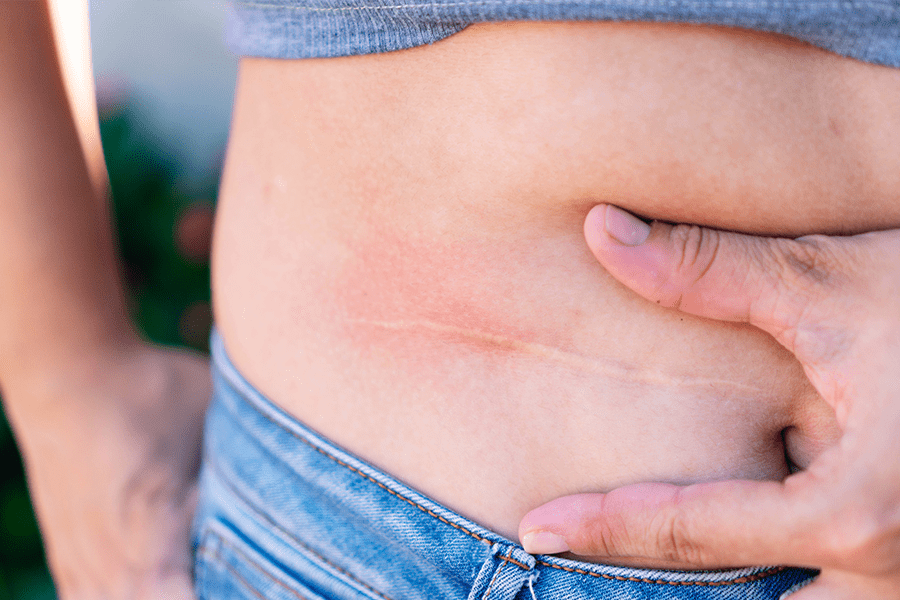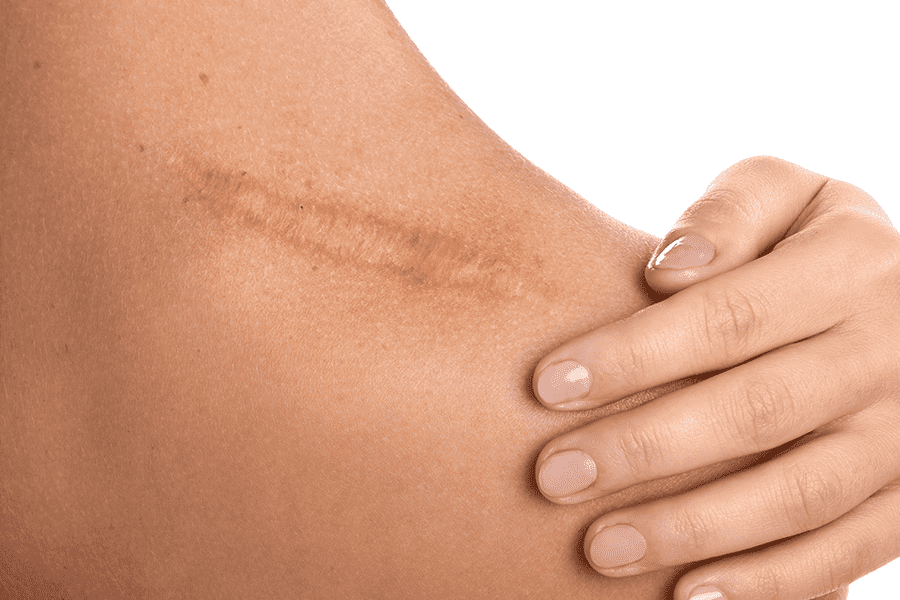- How does scar tissue form?
- Are there different types of scar tissue?
- Can you minimize the appearance of scars?
- What about old scarring? Can you get rid of an existing scar?
Taking good care of a wound after surgery or an injury is crucial when it comes to preventing serious complications like an infection. When you’re healthy, the body can heal itself by forming scar tissue. However, there are times when additional wound care is necessary. What is it that causes a wound to scar, and what can you do if a wound isn’t healing properly on its own?
How Does Scar Tissue Form?
 Technically speaking, a scar is the body’s natural way of healing itself. When the skin is damaged and a break occurs, through a scrape or a cut or even a doctor’s incision, your immune system will trigger the layers of cells within the skin to mend back together. Think of it as kind of a zipper effect. The skin will form new tissue to zip up the wound and fill in the gaps. If you think about it, a scar is an amazing healing response that your body musters to repair itself.
Technically speaking, a scar is the body’s natural way of healing itself. When the skin is damaged and a break occurs, through a scrape or a cut or even a doctor’s incision, your immune system will trigger the layers of cells within the skin to mend back together. Think of it as kind of a zipper effect. The skin will form new tissue to zip up the wound and fill in the gaps. If you think about it, a scar is an amazing healing response that your body musters to repair itself.
Scars can form from just about any injury, whether it’s a burn or a cat scratch, from acne or a poison ivy breakout, or even from surgery. The skin is an amazing organ that, when your immune system is working properly, can heal itself by knitting back together. Those scars you’re carrying may remind you of an accident you had, but they should also tell you that your skin did its job to try to heal itself.
Most of the time, this process works smoothly. New skin forms and the wound heals. Deeper breaks in the body’s sin surface are filled from the inside out with collagen to repair the wound. Collagen is a thicker material that repairs the damage, creating a scar on the skin patch your body made. Sometimes the scar tissue can be problematic. There is normal scarring and abnormal scarring. Abnormal scarring can be raised up and spread beyond the skin tear it was supposed to repair. What are these different types of scar tissue?
Are There Different Types of Scar Tissue?
 Abnormal scarring can happen after a wound has healed. Some of the kinds of abnormal scar tissue that occurs can include:
Abnormal scarring can happen after a wound has healed. Some of the kinds of abnormal scar tissue that occurs can include:
- Adhesions
- Contractures
- Hypertrophies
- Keloid scars
Adhesions are internal scars that create bonds between organs, in effect sticking them together. This can occur after surgery or a trauma.
Contractures are a type of abnormal scarring that happens when a large scar arms and tightens the skin in a way that restricts the movement of the joints, muscles, and tendons around the scars.
Hypertrophic scars, like keloids, are abnormally raised scar tissue that forms extra connective tissue around the skin wound or trauma.
Keloid scars can be a dramatic and unsightly addition to your skin’s surface. Sometimes, and we don’t know exactly why yet, a thick raised scar that looks almost like a growth, can form. A keloid usually forms on your cheeks, chest, earlobes, or shoulders. Keloids aren’t harmful to the body but they can be unsightly, causing you unnecessary emotional distress.
Can You Minimize the Appearance of Scars?
 While scars are a natural part of the body’s healing ability you may be troubled by them and just want them to disappear. There are a few things you can do to minimize the appearance of scarring on your skin.
While scars are a natural part of the body’s healing ability you may be troubled by them and just want them to disappear. There are a few things you can do to minimize the appearance of scarring on your skin.
First, we’ll start with wound care to help reduce the appearance of scars and help the body heal. Proper wound care for the average injury includes the following steps:
- Keep the wound clean by washing it with an antiseptic to reduce bacteria
- Pat the wound dry to avoid micro skin tearing (do not rub the skin)
- Use soap and water to keep the wound clean as it heals
- Apply medicated ointments like Neosporin to stimulate healing
- Corticosteroid creams can help reduce the appearance of scars over time
- Use petroleum jelly as a skin protectant to promote the skin’s natural moisture
- Alternatively, use aloe vera gel to stimulate healing and prevent scarring
- Apply Vitamin E oil, which also helps the body heal and keeps the skin supple
- Keep the wound covered to protect it from bacteria or further damage
- Change the dressing every day
- If you notice signs of redness or swelling, see your doctor
- If your wound isn’t healing well, see your doctor
Talk with your doctor about what types of vitamin supplements may help stimulate your body’s healing properties. Your doctor may even recommend massaging the scar to help break down the collagen build up in the tissue while promoting healing.
While this is basic care for basic wounds, deeper injuries to your skin’s tissue require a doctor’s care. Or, if you have chronic illnesses that affect how you heal, such as diabetes, your doctor will help with the body’s healing process. In these cases, skin grafts or other types of specialized wound care may be necessary.
Can You Get Rid of an Existing Scar?
Many minor scars, with proper wound care, may fade on their own over time. What about those stubborn scars that haven’t faded yet, but you wish they would? Some of the treatments we have available today to help with the appearance of older scars include:
- Silicone gel or sheeting can help with hypertrophic or keloid scarring
- Chemical exfoliators can help remove the dead outer layers that form the scar, lessening their appearance
- Laser therapies are used for severe scarring to help reduce their appearance
- Microdermabrasion or filler injections from a dermatologist may help with raised or pitted scarring
- Cosmetic surgery may help alter the appearance of the scarring
While scars are a part of the body’s natural response to trauma, you may decide that you simply want them to go away. Talk with your doctor about your options.
Freedom Health & Wellness offers exceptional care for patients dealing with wounds and scars. Talk with our team today about how we can help you and your loved ones heal.




